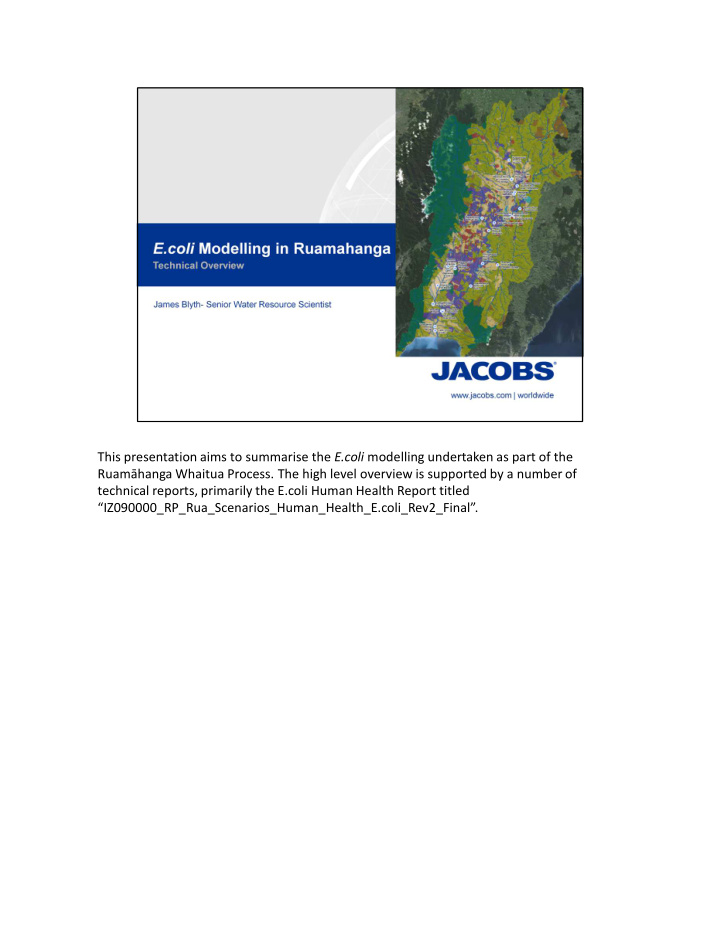



This presentation aims to summarise the E.coli modelling undertaken as part of the Ruamāhanga Whaitua Process. The high level overview is supported by a number of technical reports, primarily the E.coli Human Health Report titled “IZ090000_RP_Rua_Scenarios_Human_Health_E.coli_Rev2_Final”.
This slide summarises the approach undertaken to assign input concentrations in the model for E.coli to certain landuse types. There are 48 landuse/soil drainage combinations in the model, each with variations of E.coli EMC and DWC inputs.
This is a continuation of the previous slide, explaining how flow is generated off each landuse in the model. This is then partitioned into baseflow and quickflow (i.e. a baseflow separation analysis). The EMC’s are applied to quickflow, the DWC’s to baseflow. This is important as it links back to mitigations at a later stage where if you change the landuse due to retirement, you change the EMC/DWC inputs for that area, or if you apply reductions to DWC’s, this effects loads through baseflows, which are generally smaller than the EMC’s. EMC’s primarily influence the 95 th percentiles and also the medians.
Discuss the last two points as these hold the most importance. The model at a number of locations oversimulated the flows, which has led to a greater load than the observed at some sites. Governmental regulation changes in E.coli swimmability were implemented mid 2017, and were not calibrated for in the baseline model. Important as the swimmability criteria is based off the last 5 years of WQ data, not the 14 year record we have used for calibration.
These are the key mitigations applied in modelling that effect E.coli. Driven primarily from MPI/Agresearch farm mitigation modelling. Richard Muirhead helped advise the DWC and EMC reductions to apply to baseflows and quickflows. WWTP 95% reductions were based off a single study for the region, and in reality may have less removal than this, however in the absence of data this was applied to all sites.
NPS 2017 amended E.coli swimmability criteria
Summary of the E.coli scenario results showing how the sites change (or don’t) from the baseline model. Note that these are simulated results only, the baseline may vary in swimmability category compared to the observed. The technical report goes into more detail about the sites, how they compare to observed data and the relative changes that could be expected due to mitigations and land use change in the catchment.
This is a summary of one of the ‘red band’ sites which do not change, with explanations as to why. This detail is covered further in the E.coli Human Health Technical Report. Primarily this is showing that while the scenario modelling is significantly different to the observed for the median results, the mitigations applied in modelling can be used to approximate % changes from the baseline. These % changes (i.e. 19.4% reduction in the 95 th percentiles) can be applied to the observed to see if a change would occur that may not have been evident in the scenarios.
Discuss the results for BAU, changing at only two sites. While medians have decreased significantly in a number of sites, this is often not the cause for a site being in yellow, orange or red category. Usually these are driven by higher 95 th percentiles >1000 cfu/100 mL, which means any stock exclusion (Tier 1 mitigation) effecting baseflow loads only will have limited reductions in the 95 th .
Silver has greater changes, as it incorporates riparian planting/buffer strips removing some E.coli. In addition there is greater WWTP land treatment, more retirement (changing E.coli input concentrations). The 10% reduction is staged depending on the amount of riparian planting occurring, i.e. 100% by 2080 would be a 10% reduction, however 66% by 2040 would be 6.6% reduction. Width/thickness of buffer strip has been assumed to be equal in effectiveness in Gold and Silver.
Key changes in Gold is primarily due to a faster adoption of mitigation practices.
Recommend
More recommend